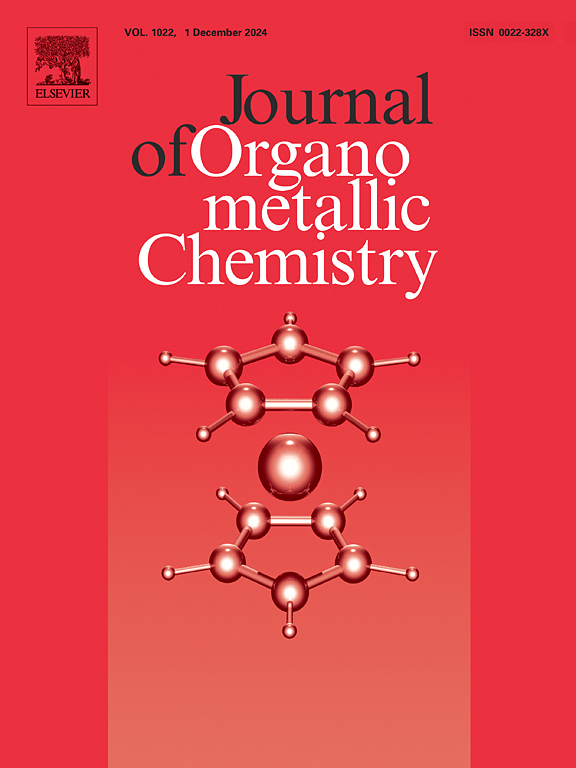In Situ generated PdNPs immobilized on polystyrene supported DABCO Dicationic ionic liquid: An efficient and reusable catalyst for Suzuki and Heck coupling reactions
IF 2.1
3区 化学
Q3 CHEMISTRY, INORGANIC & NUCLEAR
引用次数: 0
Abstract
A catalyst named PdNPs-DDIL@PS has been synthesized by immobilizing PdNPs on a DABCO Dicationic Ionic Liquid (DDIL) supported on Merrifield Resin (PS). The PdNPs (∼4.16 nm size) generated in situ were fully characterized using different techniques such as SEM, TEM, TGA-DTA, and XPS. It has been found that the catalyst is highly active in the Suzuki coupling reaction of various aryl bromides and aryl boronic acids in 70 % aqueous ethanol at room temperature. The catalyst produced the desired Suzuki coupling products in good to excellent yields. Additionally, the protocol was extended for the Heck coupling reactions in DMF at 80 °C with good to excellent yields. The catalyst attained a good turnover number (TON) of 160.00–189.92 and a turnover frequency (TOF) of 8.493–18.992 min−1 for the Suzuki and TON of 173.33–189.77 and TOF of 3.952–6.325 min−1 for the Heck coupling reactions. The catalyst displayed at least four times recyclability for the Suzuki coupling without a substantial decrease in product yields. Additionally, it boosts impressive environmentally-friendly credentials in Suzuki coupling reactions.

原位生成固定在聚苯乙烯支撑的 DABCO 双阳离子液体上的 PdNPs:用于铃木和赫克偶联反应的高效且可重复使用的催化剂
通过将 PdNPs 固定在以 Merrifield 树脂(PS)为载体的 DABCO 双阳离子液体(DDIL)上,合成了一种名为 PdNPs-DDIL@PS 的催化剂。利用 SEM、TEM、TGA-DTA 和 XPS 等不同技术对原位生成的 PdNPs(尺寸为 4.16 nm)进行了全面表征。研究发现,该催化剂在室温下于 70% 的乙醇水溶液中进行各种芳基溴和芳基硼酸的铃木偶联反应时具有很高的活性。催化剂能以良好到极佳的收率生成所需的铃木偶联产物。此外,该方案还可用于在 80 °C 下在 DMF 中进行赫克偶联反应,收率从良好到极佳。该催化剂在铃木偶联反应中达到了 160.00-189.92 的良好转化率(TON)和 8.493-18.992 min-1 的转化频率(TOF),在赫克偶联反应中达到了 173.33-189.77 的转化率(TON)和 3.952-6.325 min-1 的转化频率(TOF)。该催化剂在铃木偶联反应中显示出至少四倍的可回收性,且产物产量不会大幅降低。此外,该催化剂在铃木偶联反应中的环保性能也令人印象深刻。
本文章由计算机程序翻译,如有差异,请以英文原文为准。
求助全文
约1分钟内获得全文
求助全文
来源期刊

Journal of Organometallic Chemistry
化学-无机化学与核化学
CiteScore
4.40
自引率
8.70%
发文量
221
审稿时长
36 days
期刊介绍:
The Journal of Organometallic Chemistry targets original papers dealing with theoretical aspects, structural chemistry, synthesis, physical and chemical properties (including reaction mechanisms), and practical applications of organometallic compounds.
Organometallic compounds are defined as compounds that contain metal - carbon bonds. The term metal includes all alkali and alkaline earth metals, all transition metals and the lanthanides and actinides in the Periodic Table. Metalloids including the elements in Group 13 and the heavier members of the Groups 14 - 16 are also included. The term chemistry includes syntheses, characterizations and reaction chemistry of all such compounds. Research reports based on use of organometallic complexes in bioorganometallic chemistry, medicine, material sciences, homogeneous catalysis and energy conversion are also welcome.
The scope of the journal has been enlarged to encompass important research on organometallic complexes in bioorganometallic chemistry and material sciences, and of heavier main group elements in organometallic chemistry. The journal also publishes review articles, short communications and notes.
 求助内容:
求助内容: 应助结果提醒方式:
应助结果提醒方式:


